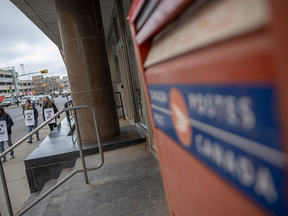Canada can cope with a weaker dollar; in fact the country needs it
Article content
We find it rather incredible that the Bank of Canada is so nonchalant when it comes to the state of the Canadian economy. The degree of excess capacity is expanding by the month, inflation has swung to disinflation and the economy (in real output per-capita terms) is contracting at a two per cent annual rate. Yet the folks in Ottawa fiddle as the macro landscape burns.
Advertisement 2
Article content
Business insolvencies have soared 87 per cent over the past year to the highest level since the peak of anxiety in 2008 when the global financial crisis was raging. The number of people entering the labour market without landing a job has practically doubled those who found one over the past year. That has resulted in more than a 20 per cent year-over-year surge in the ranks of the unemployed and it seems amazing to think that Bank of Canada officials are unaware of that statistic.
Article content
Any concerns over a resurrection of the housing bubble should be put to rest by now, with home sales in the once-hot Greater Toronto Area chilling 3.4 per cent month over month in April, losing ground in each of the past three months and down five per cent from year-ago levels. At the same time, new listings have ballooned 47 per cent year over year, and this new demand-supply backdrop has created the conditions for a flattening out in residential real estate prices.
Now that shelter costs are beginning to stabilize in real time, it won’t be long before its inflationary effects fade from the consumer price index data because the headline inflation rate in Canada, absent the housing component, is running at a grand total of 1.5 per cent, melting before our very eyes from 3.9 per cent a year ago and 6.6 per cent two years ago.
Article content
Advertisement 3
Article content
If you don’t think the Bank of Canada can cut rates without help from the United States Federal Reserve, think again. This happened in 1996-1997, 1999 and 2003-2004. How far can it deviate? Well, let’s just say that in early 1997, with the Canadian economy heading into a different orbit than the U.S. under the budget belt tightening by the Jean Chrétien-Paul Martin dynamic duo, the overnight rate in Canada got as low as three per cent while the Fed funds rate was pinned at 5.5 per cent. There is precedent.
As for the Canadian dollar, well, sure, it will depreciate, and in two of those prior periods of monetary policy divergence (1999 and 2003), it took almost $1.50 to buy a U.S. dollar. What of it? The economy needs stimulus and currency depreciation is one key to easing domestic monetary conditions. Besides, we are so damned uncompetitive in this country, with negative productivity growth and no capital deepening at all for well over a decade, that unit labour costs in U.S. dollar terms are running at five per cent year over year, which compares very poorly to the 1.8 per cent trend south of the border.
Advertisement 4
Article content
Even without the Bank of Canada going its own way, the country sadly needs a weaker exchange rate as an ongoing crutch just to realign our cost structure with the U.S. and stem the tide of net direct investment outflows. In other words, we are sure nobody is even aware of the dramatic erosion that has taken place when it comes to net direct investment (this is “bricks and mortar,” not paper securities), but there has been a net outflow of real capital out of the country each and every year since 2014 totalling nearly $400 billion (more than $50 billion alone in 2023).
This is why the Canadian dollar remains in a fundamental bear market and why it is that even in periods when oil and industrial commodities hook up, there is a muted Canadian dollar response. It is not because the “terms of trade” effect is broken as much as it has been weakened by this relentless decay in domestic competitiveness relative to the U.S.
In other words, we have to cut our prices internationally just to protect our share of the global export market, and in the process, the nation is compelled to accept a wage cut, and there was nothing in the recent federal budget to address this chronic shortfall in terms of domestic competitiveness.
Advertisement 5
Article content
It would be funny if it weren’t so sad that economic documents such as the budget turn into political manifestos aimed at buying votes in the name of “fairness” over “growth.”
Recommended from Editorial
-

Why the Bank of Canada needs to start cutting rates … Now
-

David Rosenberg: Time for Macklem to turn before it’s too late
-

Canada was once productive and competitive, but not today
How is it that the Liberals are so adept at divvying up the national income pie instead of thinking creatively to expand it. It’s as if the term “productivity” to the politicians, bureaucrats and mandarins in Canada is a dirty 12-letter word. Better to pursue supply-side growth through an unprecedented immigration policy stance (never mind that there has been no economic payback, judging by the continuous contraction in real output and income in per-capita terms) than embark on measures to bolster productivity growth, which is the mother’s milk for future prosperity. But why bother when nobody outside the realm of economics even understands what productivity means, and it’s neither an attention grabber in election campaigns nor a vote getter at the polls.
Brian Mulroney and Michael Wilson got it. Chretien and Martin got it. But Justin Trudeau and Chrystia Freeland? Not so much.
David Rosenberg is founder and president of independent research firm Rosenberg Research & Associates Inc. To receive more of David Rosenberg’s insights and analysis, you can sign up for a complimentary, one-month trial on the Rosenberg Research website.
Bookmark our website and support our journalism: Don’t miss the business news you need to know — add financialpost.com to your bookmarks and sign up for our newsletters here.
Article content
Bank of Canada should cut rates with or without the Fed
2024-05-07 15:15:55








